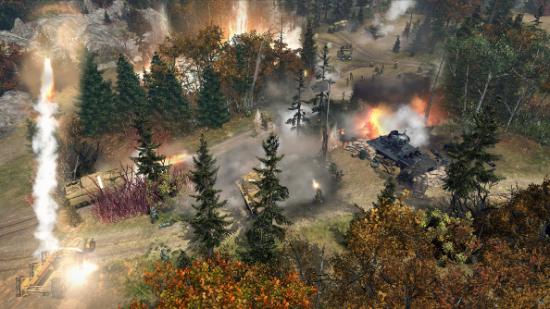Company of Heroes 2 had big, muddy, army issue boots to fill in 2013, and its Eastern Front campaign managed to be a worthy successor to Relic’s original World War 2 RTS. Since then, players have spent over 40 million hours fighting across Europe and Russia; that’s over 400 years in one of the best World War 2 games on PC.
But with competition from competitive RTS games like StarCraft 2 and the neverending hordes of MOBAs, how does it stay healthy? Plenty of exercise and a good diet? I had a chat with executive producer Greg Wilson to find out what Relic’s been doing to keep people invested in the war.

Since releasing Company of Heroes 2 in June, 2013, Relic’s been busy. The studio’s been tweaking the core game, fattening it up with new features, and last year released two chunky expandalones, Western Front Armies and Ardennes Assault. Player numbers are on the rise, and it’s the healthiest it’s been since July, 2013, just after the game launched.
“I think a bunch of factors contribute to that,” Wilson tells me. “We think we’ve delivered a really high quality product in Company of Heroes 2. And Company of Heroes, in terms of brand recognition, is one of the most popular and enduring franchises of all time for RTS, and CoH2 has proven to be a worthy sequel. It’s been well received by critics and fans alike, and for us, it’s just building on that, and offering a really diverse content offering that will appeal to a broad range of player types.”
Wilson lists the “player types” and they’re a varied bunch. PvPers, people who just want to experience the campaign, casters, groups of co-op buddies. With a growing community with different tastes, Relic has attempted to cater to them all by putting out two broadly different expansions. There’s Ardennes Assault, a sandbox campaign spread out across a meta map, filled with dynamic missions; and there’s Western Front Armies, which was dedicated entirely to multiplayer.

I wondered if the attention given to the multiplayer has encouraged more people to stick around, duking it out over once idyllic European villages and frozen Russian cities.
“Our multiplayer audience is our most active and engaged audience when it comes to regular activity,” says Wilson. “People do come into the franchise from lots of different access points. The campaign is one that’s generally a linear experience, so people will play it once or twice and then transition into multiplayer, co-op or competitive PvP.”
But it’s not just about keeping co-op and PvP players happy; it’s about trying out new things.
“Now, in Ardennes Assault, we introduced a new system, which I know you’re familiar with, and that was the meta map. And that allows not just winning or losing a battle to impact your decisions, but how you won or lost those battles, and that introduced another mechanic for us to introduce to our players and allow them to have more options to have for replaying campaign content.”
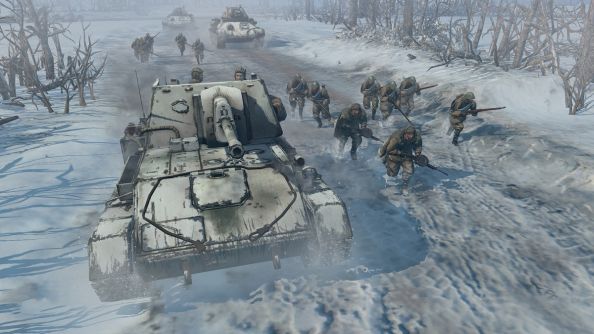
I called Ardennes Assault the best Company of Heroes 2 has ever been when I reviewed it last year. Everything great about the series was there, but with another strategic layer, and for once, the possibility to lose battles but win the war. Both expansions are dramatically different from their forbearer, so much so that it seems like a shift in design philosophy, away from scripted campaigns, has occurred at Relic. But rather than a shift, Wilson says that the studio is just expanding its repertoire.
“I don’t think it’s moving away from any one thing, but I absolutely think that we’re adding to our repertoire here. And I think that sort of dynamic, layered experience is something that’s been really well received by our fans, and that we’re going to continue looking to explore that in the future, and mix it in with some of those really well crafted and scripted moments that bring specific elements to light.”
The Western Front is safer, too. Company of Heroes 2’s campaign attempted to dramatise the harsh “reality” of the war on the Eastern Front, complete with Russian officers murdering their own troops. It was divisive, and didn’t go down particularly well in Russia, but it was an interesting change in tone from the traditional, heroic, good versus evil of the original Company of Heroes campaign. With the two expandalones, Relic went back west, though.
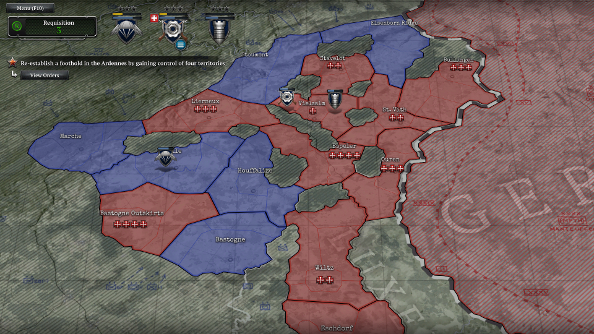
“There’s a familiarity with the Western Front,” explains Wilson. “The story’s been told more times, so it’s on the tip of people’s tongues, and it sort of takes them back to their school days where they can actually talk intelligently about some of those encounters and battles and units.”
While Ardennes Assault was lighter on story than the core game, Relic used the officers of the various player-commanded companies to give the US Forces a human face, and nameless soldiers continue to shout over the din of battle, sometimes crying out warnings or orders, or sometimes just out of fear.
“I think that all matters, and it matters in different ways to different people,” says Wilson. “So what we want to do is provide great choices for people to make and expose them to the game in a way that they can consume it in any way the want.”
Now that we’re in the era of eSports and casting, with tournaments drawing massive crowds, both online and in person, and even bigger prize pools, the way a lot of players are consuming games is through watching others play – competitively or just for a lark. That’s not gone unnoticed at Relic, and the studio’s already been arranging tournaments, and more are coming.
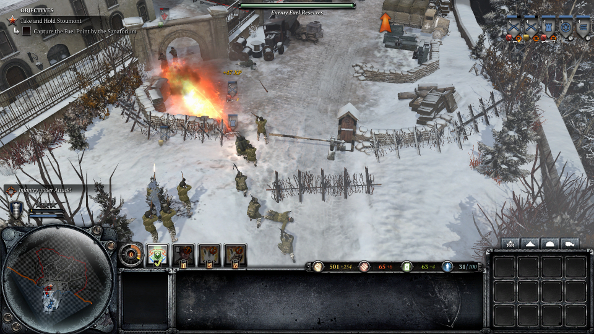
“There’s an ongoing relationship we’ve established with the ESL, and we’ll be working – this year – to create a tournament,” Wilson tells me. “Look for big things from Company of Heroes 2 and ESL partnership in 2015.
“Tying that back into some of the features we’ve released, we specifically released our observer mode to help support things like tournaments and casting, and sort of empower our community,” he continues. “We’ve got this really passionate community that have even taken the time to create their own tournaments. They’ve generated their own prize money, sometimes. So it’s really just about trying to give that community an opportunity to express themselves, and also to share with the world the great game they’ve helped to build.”
Company of Heroes 2 isn’t typical of an eSports game, with its slow, methodical pacing with sieges, and men huddling beneath cover. Wilson thinks that’s part of the appeal, though. He says that it helps that it’s not just about actions-per-minute, which makes it more accessible.
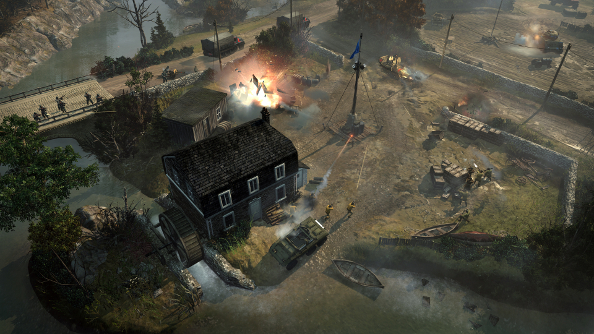
Accessibility seems to be the key word in why Relic thinks that Company of Heroes 2 can succeed as an eSport title, and why Wilson hopes that it could become a core aspect of the series. Battles are easy to understand, not just because they aren’t about rapidly firing off attacks and abilities and sprinting around maps, but because the units are easier to understand.
“It’s really easy for people to understand, when a tank is going up against infantry, if that’s a good matchup or not. If the infantry doesn’t have anti-tank or there’s no AT gun to support it, you can understand immediately that the matchup is bad, opposed to some other games, where it can be difficult to understand without some deep knowledge about what the units are, what the counters are and what the special abilities are.”
When there are no tournaments running, there are always casters. Wilson notes that there are casters who daily feeds when they’re playing through the campaign or skirmishes, while others might cast top-rank matches from observer mode.
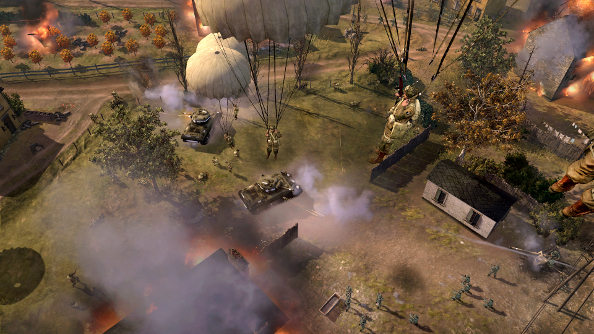
I pestered Relic for a few notable casters that you’re bound to catch playing and streaming, if you lovely folk wanted to dip in, but haven’t known where to look. I was told to check out Imperial Dane (YouTube/Twitch), Romeo (YouTube/Twitch) and GeneralsGentleman (YouTube/Twitch).
With Ardennes Assault only a couple of months in their rear view mirror, Relic aren’t ready to announce anything new for Company of Heroes, but neither is the developer going to leave the game, or its community, alone. “From us just looking at how Company of Heroes 2 is performing, and we look back at Company of Heroes 1, it is – across the board – outperforming CoH 1,” Wilson points out. “There are lots of big plan for the franchise in 2015 and beyond, and we’re excited to head in the direction that the fans are asking us to go in.”
